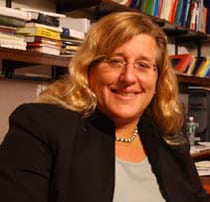 Following up on her recent success story of developing portable sensors for explosives’ detection, Materials Views had a chat with Professor Karen Gleason, Associate Dean of Engineering at MIT, to find out more about her research.
Following up on her recent success story of developing portable sensors for explosives’ detection, Materials Views had a chat with Professor Karen Gleason, Associate Dean of Engineering at MIT, to find out more about her research.
LW: Have you always wanted to be a scientist, or did you see yourself at some point on a different career path?
KG: In 7th grade, it was mandatory for everyone in my class to complete an independent science project over the course of the year. From that point on, I was complete hooked on scientific research. Some of my favorite reading at that time was Isaac Asimov’s collections of popular science essays.
LW: What motivated you to choose a career in academia instead of industry?
KG: The freedom to choose which intellectual problems to attack and opportunity to engage with motivated students were the main drivers. Both factors remain very important to me today.
LW: What got you interested in Materials Science as a subject, and more specifically in CVD processes?
KG: My doctoral studies started at the time of an early energy crisis and I had the opportunity to work on amorphous silicon solar cells fabricated using CVD. This research blended together chemical synthesis, spectroscopy, materials, reactor engineering, with device physics. The knowledge from these various disciplines often represents a jigsaw puzzle that is intriguing to fit together. For example, it has been very rewarding to see that fundamental understanding of how a molecule absorbs on a surface impacts the design and commercial viability of reactors several meters in diameter.
LW: What are your current research interests?
KG: My group’s current theme is molecularly designing responsive and electrical active CVD polymers and integrating them into optoelectronics, MEMS devices, sensors, membranes, and medical devices. CVD is a standard method in the semiconductor industry for high purity inorganic materials. Having a fully compatible process for organics offers new capabilities such as chemical specificity, biological compatibility, and layers which change in thickness or properties in response to the external environment. We are exploiting the ability of the CVD processes to coat complex geometries in order to fabricate nanoscale implantable sensors and to deposit devices directly on fiber-based substrates like paper and textiles.
LW: What do you enjoy most about your work?
KG: Since my first day as a professor, brainstorming research ideas with the graduate students in my group has been and remains the absolutely best part of my job.
LW: What’s the coolest thing you’ve ever discovered?
KG: The unexpected is always the best result. About 15 years ago, we had set an entirely fundamental scientific goal of proving a longstanding hypothesis that both ions and neutrals need to be present for polymer film deposition. We devised a reactor which would controllably make only neutrals and expected to observe no deposition. Instead, film deposition was rapid and of higher quality than when ions were present. This fundamental discovery has lead to two commercial applications with many more in the pipeline.
LW: What do you think are the greatest challenges facing scientists at the moment?
KG: Funding mechanisms and the academic promotion process places tremendous pressure to work on popular topics and to strive for rapid publication. However, breakthroughs can come from unexpected research areas and their full exploitation may require careful consideration of prior work, experimentation, and analysis, all of which require time. In order for scientists to have a greater impact, societal and commercial factors which will influence the potential adoption of technology, need greater consideration before the first experiment is done.
LW: Finally, where do you see the field of materials science in 10 years time?
KG: In the past, simply synthesizing and characterizing a new material was often sufficient for high-impact publication. Today, a prototype application is typically required. In the future, the need for greater levels of integration of prototypes in to systems and input of end users of these systems are likely to drive research directions in materials. Additionally, with the continuing advances in computation and multi-scale modeling approaches, a deeper integration of quantitative approaches into materials synthesis, property optimization, device fabrication, and system design is anticipated.

















